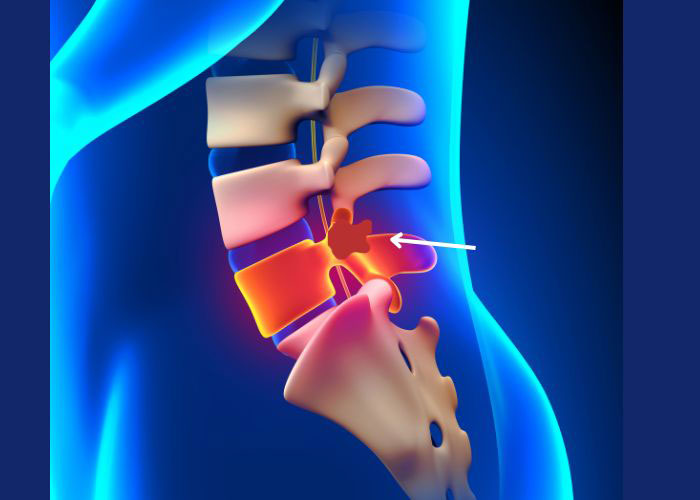Lumbar Synovial Cysts Specialist
Experience relief from back pain and regain your mobility. Receive personalized treatment for lumbar synovial cysts, tailored to your unique needs. Doctor Andre M. Samuel, orthopedic spine specialist, treats patients in the Clear Lake, Houston, Sugar Land, TX area who have been diagnosed with lumbar synovial cysts. Start your journey to recovery by contacting Dr. Samuel’s team today!

What are lumbar synovial cysts?
Lumbar synovial cysts or facet cysts are benign, fluid-filled sacs that develop in the spine’s facet joints. The facet joints are found on the back of the spinal column, and help the spine move and remain stable. These cysts are most often located in the lower back (lumbar spine) and typically develop because of degenerative changes in the spine due to aging. If a facet cyst becomes large enough, it can cause back and leg pain and lead to other neurological symptoms due to nerve compression. Doctor Andre M. Samuel, orthopedic spine specialist, treats patients in the Clear Lake, Houston, Sugar Land, TX area suffering from lumbar degenerative disc disease.

What are the common causes of lumbar synovial cysts?
Facet joint degeneration is the leading cause of lumbar synovial cysts. When the joint breaks down, the body may produce more synovial fluid to compensate and keep the joints moving smoothly. Sometimes this extra fluid will build up inside one section of the synovial sac causing the cyst. It can happen as a result of aging, arthritis, or mechanical stress on the spine. Risk factors include:
- Age – Those over the age of 65 are more likely to develop facet joint degeneration and lumbar synovial cysts.
- History of back pain – Patients with a history of back pain or other spinal conditions may be at higher risk.
- Osteoarthritis: This condition, which causes the cartilage to break down, can lead to the development of facet cysts.
Jobs or activities placing repetitive stress on the spine can also contribute to the wear and tear of the facet joints leading to lumbar synovial cysts. Excess body weight also places undue stress on the spine which can lead to the formation of lumbar synovial cysts.
What are the first signs or symptoms of lumbar synovial cysts?
Lumbar synovial cyst symptoms vary from patient to patient and depend on the size and location of the cyst. Some patients experience no symptoms at all while others have severe pain. Common symptoms include:
- Lower back pain which is often better when sitting and worse when standing.
- Sciatica which is characterized by sharp, shooting pain through the buttocks and down the leg, usually on one side.
- Numbness, tingling, or weakness in the legs or feet.
- Difficulty standing or walking for extended periods.
A rare complication of facet cysts is a condition known as cauda equina syndrome, which causes the compression of nerves at the base of the spinal cord.
How are lumbar synovial cysts diagnosed?
During an appointment, Dr. Samuel takes a medical history and completes a full physical exam before making a lumbar synovial cyst diagnosis. He may order X-rays, an MRI, or a CT scan to visualize soft tissue structures like facet cysts and to assess the degree of degeneration in the facet joints. Once Dr. Samuel makes a diagnosis – he and his team develop a detailed treatment plan.
What is the treatment for lumbar synovial cysts?
Treatment options depend on the severity of symptoms and the impact on a patient’s quality of life. Dr. Samuel typically opts for conservative treatments first, before discussing surgical options. Conservative treatments include:
- Rest
- Physical therapy
- NSAIDs to manage pain
- Corticosteroid injection to help reduce pain and inflammation.
If conservative treatments fail to provide relief or if there is nerve compressive, Dr. Samuel may recommend surgery. Several different procedures may be performed either alone or in conjunction with each other. They include:
- Facet Cyst Excision – A minimally invasive procedure to remove the lumbar synovial cyst through a 18mm tube.
- Laminectomy – Removing a portion of the vertebrae that covers the spinal cord.
- Facetectomy – Removal of part of the facet joint to access and remove the cyst.
- Spinal Fusion – The joining of two or more vertebrae together to stabilize the spine.
Dr. Samuel’s decision to operate on a lumbar synovial cyst may also depend on the patient’s overall health as well as the size and location of the facet cyst. Before the surgery, each patient talks with Dr. Samuel about the benefits and risks of the procedure.


